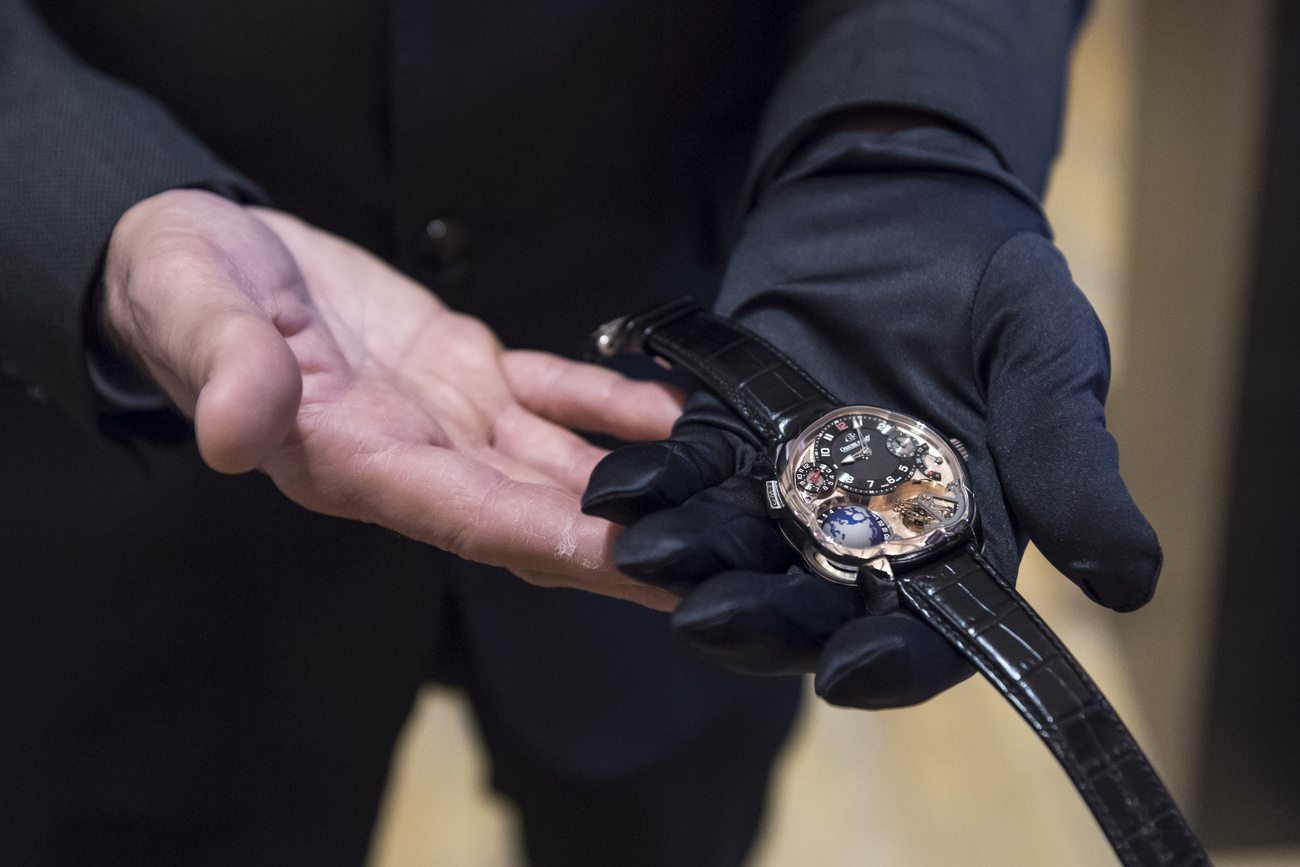Swiss watch exports soar from one record year to the next

For the third year running, watch exports grew strongly in 2023, topping the CHF26 billion ($30 billion) mark for the first time. But a few dark clouds could be appearing on the horizon.
If there is one economic sector that seems unperturbed by the current unpredictable global economic and political arena, it is the watchmaking industry. Neither inflation, nor the weak growth seen worldwide last year, nor the wars in Ukraine and the Middle East disrupted the forward momentum of Switzerland flagship industry, which sells more than 95% of its products abroad.
Watch exports reached a new record in 2023, according to figures published on Tuesday by the Federation of the Swiss Watch Industry. Their value rose by 7.6% compared to 2022, to reach CHF26.7 billion.
As in the previous two years, the United States is the most important market for sales of “Swiss made” timepieces (up 7% to CHF4.1 billion). China takes second place in this ranking (7.6%, to CHF2.7 billion), ahead of Hong Kong, which proved to be the most dynamic market last year, with an increase of 23.4% to CHF2.3 billion.
“The first half of 2023 was very buoyant, particularly in China and the United States,” says Oliver Müller, watchmaking expert and founder of the luxeconsult agency. “Hong Kong has recovered and remains an important distribution platform for other Asian markets, despite the considerable reduction in the number of points of sale during the pandemic. On the other hand, the second half of the year was much quieter for all the players in the industry.”
The ‘big four’
Once again, it was the high-end and very high-end watchmaking houses that helped the Swiss watch industry achieve this new record. Watches with an export value of more than CHF3,000, meaning that the final selling price is more than CHF7,500, accounted for more than three-quarters of the total value of exports. “Growth was concentrated on very few players, mainly those in the ‘big four’” said Müller. The “big four” are the major independent brands: Rolex, Audemars Piguet, Patek Philippe and Richard Mille.
In the entry-level and mid-range levels, two brands came out on top: Swatch, which sold more than two million units of its “Moonswatch”, an affordable version (CHF250) of Omega’s Speedmaster Moonwatch, and Tissot, another brand belonging to the Swatch Group, which took off thanks to the launch of its PRX line.

More
Swiss watchmaking: where things stand
Boosted by the success of the “Moonswatch” and the post-Covid rebound, the total number of watches exported is up once again (7.2% in 2022 to 16.9 million in 2023). Over the long term, however, the trend towards a general move upmarket and a decline in volumes continues. In the early 2000s, the industry exported nearly 30 million watches. This is twice as much compared to today.
Highest level of employment in 50 years
This sustained growth is also reflected in a marked increase in employment: more than 4,400 new jobs were created in the watch industry last year. Companies in this sector, which operates mainly in the north-western cantons of Switzerland, now employ more than 65,000 people, a level not seen since the 1970s.
Headcount rose particularly in the administrative sector (2,680 new positions). Production staff also continued to grow (1,588 new jobs), but this increase was held back by a shortage of skilled labour.

More
Could international graduates solve worker shortages in Switzerland?
“The industry is experiencing a shortage of staff with certain specialised competencies. This is unavoidable in a context of historically low unemployment in Switzerland,” says Ludovic Voillat, secretary general of the Employers’ Convention of the Watchmaking Industry.
The end of the boom years?
After three years of post-Covid euphoria, 2024 should mark a return to normality for the industry.
Most analysts anticipate a weak or even slight decline in the growth rate. “We can expect a decline of around 5%, which would put watchmaking on par with 2022, which was still the second-best year in the history of the Swiss watch industry,” says Müller.
At the start of 2023, a ramp down in production was observed in some companies. Many subcontractors, who are the first affected by any downturn in the economy, are having to postpone orders.
Should we fear a wave of redundancies following the previous year’s massive recruitment phase? “2024 is likely to be more complicated, and that will inevitably have an impact on employment,” says Voillat. “But we’re expecting the workforce to stabilise, which would be excellent news given the current high levels.”
Original French text proofread by Reto Gysi/op/translated by amva

In compliance with the JTI standards
More: SWI swissinfo.ch certified by the Journalism Trust Initiative









You can find an overview of ongoing debates with our journalists here . Please join us!
If you want to start a conversation about a topic raised in this article or want to report factual errors, email us at english@swissinfo.ch.